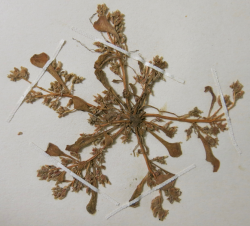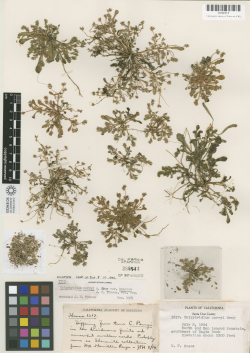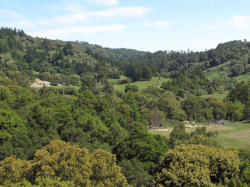
threatened

Single individual from TOPOTYPE herbarium sheet (J. H. Thomas and W. R. Ernst, 24 June 1956). Plants were collected at the same locality as the type specimen in the Santa Cruz Mountains, Santa Cruz County, CA.

Type specimen of Calyptridium parryi var. hesseae (HOLOTYPE, CAS388413, 2 July 1954), collected by Vesta F. Hesse in the Santa Cruz Mountains, Santa Cruz County, CA. Both the HOLOTYPE and ISOTYPE are housed at the California Academy of Sciences.

Vicinity of type collection in the Santa Cruz Mountains, Santa Cruz County, CA. Photo by Dylan Neubauer.



This fact sheet was prepared by Dylan M. Neubauer under award NA04N0S4200074 from the National Oceanic and Atmospheric Administration (NOAA), U.S. Department of Commerce (DOC). The statements, findings, conclusions, and recommendations are those of the authors and do not necessarily reflect the views of the NOAA or the DOC.
© Copyright 2006, Elkhorn Slough Coastal Training Program
Last updated: Mar 11, 2016 12:49
Common Names - Santa Cruz Mountains pussypaws
Family - Montiaceae (Miner's Lettuce Family)
State Status - none
Federal Status - none
Habitat
Flat to gently sloping sandy or gravelly openings in chaparral, oak woodland, or coniferous forest, often in disturbed areas or in poor soil where there is little competition; 305–1530 m.
Key Characteristics
Annual herb, 2–11 cm, from a slender taproot, stems leafy, spreading to ascending; leaves basal and cauline, 1–3 cm long, basal generally withering in fruit; inflorescence 1–3.5 cm long, axillary, open to dense, bracts ovate to elliptic; sepals 2–4.5 mm long, ovate, generally unequal in width, with margins generally narrowly scarious; petals 4, 1.5–3 mm long, generally white, quickly deciduous and forming a caplike structure covering the fruit tip, stamens generally 3, stigma ± sessile; fruit 3–6 mm, ovate to oblong, readily deciduous; seed 0.5–0.7 mm, with marginal papillae (Guilliams and Miller 2016).
Though Calyptridium parryi var. hesseae can be difficult to distinguish from the widespread, and closely related, C. monandrum, the former has fully developed, planar capsules that are ± ovate to lanceolate and ≤ 2x the length of the sepals, while the latter has slender (< 1 mm wide), oblong to linear, non-planar capsules that are ca. 3x the length of the sepals (Guilliams personal communication 2010; Simpson et al. 2010; Guilliams and Miller 2016).
Calyptridium parryi var. parryi occurs at higher elevations than var. hesseae (1400 –3500 m), has fruit generally not deciduous, and seed papillate throughout. (Simpson et al. 2010; Guilliams and Miller 2016).
Flowering Period
May to August
Reference Population
Chew’s Ridge, Santa Lucia Mountains (Monterey County)
Global Distribution
Known from Monterey, Santa Clara, and Santa Cruz counties (CNDDB 2017). Specimens labeled as this taxon from San Benito and Fresno counties are considered to be intermediate between C. p. var. h. and C. p. var. parryi (CNPS 2008). Specimens from San Luis Obispo County have been misidentified (Keil and Hoover, unpublished manuscript).
Discussion
Originally collected by Boulder Creek resident Vesta F. Hesse in the Santa Cruz Mountains in the early 1950s, her name is commemorated in the varietal epithet of this taxon (Carter and Thomas 1986). Miss Hesse’s numerous collections formed the basis of the 1961 Flora of the Santa Cruz Mountains of California by John Hunter Thomas.
Calyptridium parryi var. hesseae was described in 1956 by Thomas from a type specimen collected near Eagle Rock on Ben Lomond Mountain in Santa Cruz County. The Jepson Manual (1993) treatment recognized three varieties, including var. hesseae, however the 2003 Flora of North America, Volume 4 [under Cistanthe parryi (A. Gray) Hershkovitz] treatment did not, due to the variability of what were deemed “minor characters” between populations (Kelley et al. 2004). An in-depth morphological analysis (Simpson et al. 2010) concluded that four varieties, including var. hesseae, were distinct enough to merit taxonomic status, and the latest treatment (Guilliams and Miller 2016) includes C. parryi var. hesseae as a valid taxon.
Conservation and Threats
In 2008, Calyptridium parryi var. hesseae was re-ranked from California Rare Plant Rank 3 to 1B.1 (CNPS 2011).
Known from 11 occurrences worldwide, a definitive example of this highly localized annual was not documented for decades. During the 2007 and 2008 field seasons, researchers surveyed over the range of the taxon, with special focus at the type locality, but were unsuccessful at locating any specimens that were “directly atributable” to var. hesseae (Guilliams 2008). A specimen collected from Chew’s Ridge, in the northern Santa Lucia Mountains in Monterey County, appeared to be more similar morphologically to var. parryi, though plants examined were immature (Guilliams 2008). Chew's Ridge burned in the 2016 Soberanes Fire. The area was surveyed in 2017, but plants were not located.
In 2020, ca. 50 individuals were relocated near the type locality. There had been a prescribed burn in the area the year previous. In 2021, most likely the largest extant population (ca. 300 individuals) was found on private property on Ben Lomond Mountain. This occurrence had not been observed since 1956, and was in an area that burned in the 2020 CZU Lightning-Complex Fire.
Threats include development, fire-suppression, non-native species, and road-maintenance activities (CNPS 2011).
References
California Natural Diversity Database (CNDDB). 2017. RareFind 5 [Internet]. California Department of Fish and Wildlife [accessed 15 December 2017].
California Native Plant Society (CNPS), Rare Plant Program. 2011. Calyptridium parryi var. hesseae. Inventory of Rare and Endangered Plants (online edition, v8-02). California Native Plant Society, Sacramento, CA. Website http://www.rareplants.cnps.org/detail/59.html [accessed 20 February 2016].
Carter, A. M. and J. H. Thomas. 1986. Vesta Florence Hesse, 1901–1982. Madroño 33(4):307–308.
Guilliams, C. M. 2008. Communication in CNPS Forums Rare Plant Status Review of Calyptridium parryi var. hesseae.
Guilliams, C. M. and J. M. Miller. 2016. Calyptridium parryi var. hesseae, Revision 2, in Jepson Flora Project (eds.) Jepson eFlora, http://ucjeps.berkeley.edu/cgi-bin/get_IJM.pl?tid=55522 [accessed 20 February 2016].
Keil, D. J. and R. F. Hoover. Unpublished manuscript. Vascular plants of San Luis Obispo County, California, Second Edition.
Kelley, W. A., J. M. Miller, and J. G. Packer. 2004. Cistanthe. P. 463 in Flora of North America Editorial Committee, eds. 1993+. Flora of North America north of Mexico. 19+ vols. New York and Oxford. Vol. 4. http://www.efloras.org/florataxon.aspx?flora_id=1&taxon_id=242415718 [accessed 21 February 2016].
Simpson, M. G., M. Silveira, and C. M. Guilliams. 2010. Taxonomy of Calyptridium parryi (Montiaceae). Madroño 57(3):145–160.
Thomas, J. H. 1956. A review of Calyptridium parryi. Leaflets of Western Botany 8:9–11.
Wilken, D. H. and W. A. Kelley. 1993. Calyptridium. Pp. 896–898 in J. C. Hickman (ed.), The Jepson manual: higher plants of California. University of California Press, Berkeley, CA.
